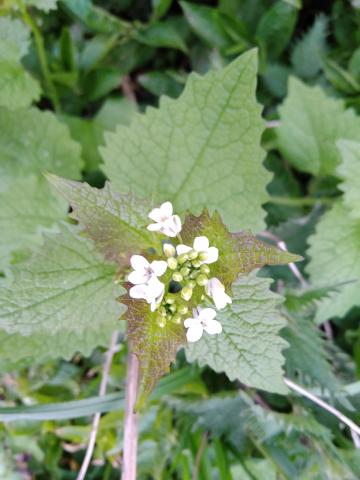Garlic Mustard

This is Alliaria and I observed it growing on Long Lover Lane, near our chapel. It’s a plain little plant with a pretty but otherwise insignificant flower, hardly worth the trouble of halting a walk to take its picture. Yet the EatWeeds website, which gives its vernacular name of garlic mustard, makes the following observations:
Parts used for food
Leaf, stems, flowers, seeds, root.
Food uses
The release of a garlic smell and taste when the leaves are crushed led to the use of garlic mustard as an alternative to true garlic. Thus it can be said to have the same uses as garlic in food preparation and cooking. The wild herb also makes an excellent savoury salad green, sauce and potherb. Seeds used as a pepper substitute. The root has wasabi notes, and the flavour ranges from ‘very hot’ to ‘sweet with mild heat’ depending on location and region.
Not bad for a common little plant growing by the lane. Many edible plants have but one or two parts which a human may safely consume; occasionally, the roots, or the flowers, or the stems prove poisonous. Here is a plant which may be consumed in its entirety. Although I am not planning to put the claims of the good folk at EatWeeds to the test, I do find myself impressed.
Too many of us consecrate but parts of our lives to Christ. He may have our weekends, but not our weekdays; He may have our tithe, but not the rest; He may have our prayers and attention when we need Him, but the TV and radio will have it the rest of the time. Would that we gave ourselves to Him entirely- what beauty we might gain and utility we should offer.
But know that the Lord hath set apart him that is godly for himself: the Lord will hear when I call unto him. Psalm 4:3
- Log in to post comments


 Sunday Worship 10.45am & 6.00pm
Sunday Worship 10.45am & 6.00pm